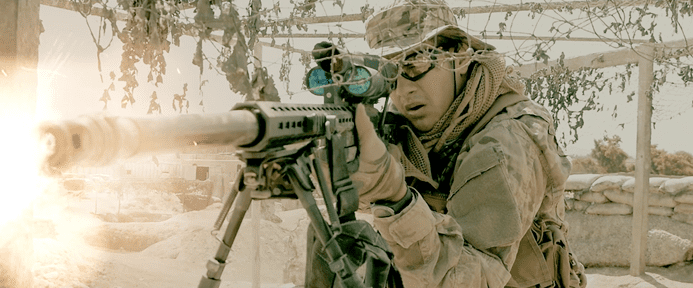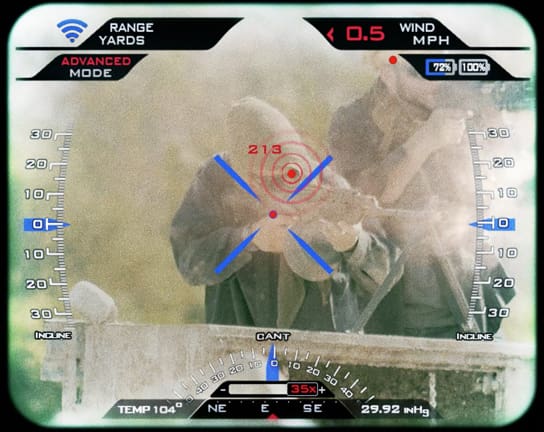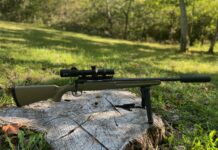Nick saw TrackingPoint’s promo vid envisioning some future (or maybe current) sandbox, one with TP-enabled ballistics. Let’s say Nick was, well, skeptical and hoped TrackingPoint’s Oren Schauble would cut loose with some more deets. Or at least their whole vision thing for where they see the technology going. Well it didn’t take Oren long to crack back, directing Nick to a microsite they’ve set up, shotmade.com, along with the following excerpt:
We live in a time of disruptive technologies, where frequent advances change the world so fast we barely remember what it was like before. As TrackingPoint has disrupted traditional small arms and optics technologies with the smart rifle by combining target tracking, sensor arrays, and ballistic computation with integrated firing systems, we have also conceived of a new era of warfare over the next few decades – complete with both threats and countermeasures that have yet to be invented – and have a vision for how smart weapons technology will play a significant role.
At TrackingPoint, collaboration is in our company DNA – shooters, veterans, engineers, and inventors sit side by side everyday mapping out our vision of the future and the products that will give hunters and shooters and those that serve our nation a competitive edge. We started this business by democratizing extreme distance accuracy and allowing shooters to share their experience in near real time via streaming video and prove their shots with recorded videos with smart rifles. As we unveiled our technology to hundreds of commercial and government end users, we received critical feedback on how to maximize the use of smart rifle technology in the full spectrum of current and future military and law enforcement operating environments. Based on that feedback, we are further investing in low light and night capabilities, wind sensing, and geo-location modules to make smart weapons more capable as well as expanding our offerings over time to include a greater variety of actions, calibers, and shooting systems.
Yet smart rifle technology is more than just making shooters more accurate – it can form the core platform for a networked battlefield with its internal sensors, computing power, and communication architecture. Dynamic, interactive common operating pictures using something as simple a commercial off the shelf tablet, inter and intra-squad target handoff, a constant stream of near real time critical data running between squad members, units, and command structures – these are no longer concepts drawn from science fiction or the latest video game – these are real capabilities that are months not years away. Just as GPS changed warfare at the turn of the century, the next changes will occur via smart weapons at the small unit level where massive increases in baseline lethality and situational awareness with the least amount of training will be possible.
Our first set of ideas on the networked battlefield are contained in a new microsite on our ShotMade Blog, complete with a live action video teaser showcasing new prototypes and capabilities. As the feedback loop continues on, and as we develop new concepts, this will grow into a place where we can show you updates and concepts of some of the most interesting work related to our technology yet, and provide insight into the process of growing a company’s vision into reality.
Future concepts will include ways in which firing systems can achieve minimal to no muzzle velocity deviation shot over shot, ways in which small arms munitions and delivery systems can be designed to defeat armored unmanned threats from the air, ground, and sea, and ways in which emerging image recognition technologies can integrate with the networked battlefield concept.
Oren Schauble
TrackingPoint






So are these guys paying?
No, we get no dollars from TrackingPoint.
Having worked on the SA (Situational Awareness) or C2 side of the house just recently and for many years…. No, it’s not ready. We can barely get BFT to work in real time, let alone a fully integrated COP (Common Operational Picture). First and foremost, the transmission medium is not ready to handle the bandwidth that the current COP requires, let alone any future additions. Is it doable? Yes and no. Anything is possible, with unlimited resources and accepting some consequences/risks. Is it viable? No, not yet.
And the whole thing goes kablooey when a kid in Argentina decides to screw with the SATCOM and the wonderful logisticians position ALL the batteries in a container on a ship in Norfolk. Not considering the havoc a good lightning storm could create with the sensitive electronics. Or the bad guys firing up an old, unshielded DC generator and bathing the whole area in EMP.
Not even close to ready from a practical standpoint; I agree completely.
I’ve never put all the batteries in Norfolk, only most of them. The rest are in Charleston, SC…..
Nice idea and all. Better shots means cleaner kills and less ammo the boys and girls in the field waste trying to stay alive. But the first rule of computers is: Any system now matter how advanced is only as smart as the guy who programmed it. And super calculations aside, there is simply no replacenent for a sniper’s skill, reflexes and instinct. The same reason UAV’s can never completely outmode pilots.
Haha. “TP enabled ballistics” stock up on two ply double rolls they will go farther… So our future battlefield will be a video game. Parents put the treadmill in front of the Xbox so our future soldiers can practice running and gunning!
The ‘Next Sandbox’ may be at a Vet Memorial or a backyard near you.
Just saying
I read the post above and even went to their website and I only understand about a third of what they are talking about. I guess that I’m just too old a dog to learn all these new tricks. I’m more comfortable with line up the sights, make the gun go BOOM and watch the target fall. If I gotta program the darn gun just to shoot, it will be like my VCR player, not used much.
Be realistic. When the TrackingPoint accurately controls full-auto fire from medium and heavy machine guns, mortars, and RPGs, it’ll matter on a battlefield. It’ll never matter in CQB because it’s just more crap to slow down easy-to-aim fire. Perhaps it would be useful for long-range sniping, but currently that isn’t a failure point.
It might improve elk hunting results if the guy with one can find anybody to hunt with and the law would allow it. I would guess these things may become legal hunting tools for use by paraplegics only.
That depends… Tracking point in its current form is no good CQ, but it could be modified with current tech to be better than current human reflex. Imagine an M4 fully auto, that will only fire on target painted by a UAV, bot, or robot. Operator places bug, network rifle, hold down the trigger, breach and sweep the room with your rifle trigger held down, and let it fire center mass 3 shots per highlighted target.
It would be ridiculously accurate, fast, and deadly. The safety could be redesigned to be either in safe, TP, or manual. Thus areas where target painting isnt possible the gun still works. Maybe Im missing somethng, but i would have loved a system like that while i was in.
The UI/UX Design is horrible. What year is it? The interface looks like something I pulled out of my butt when I first started designing.
Pass it off to real designers. Enough of the StarTrek garbage.
That said… Looks like an awesome tool, though it is cheating, I wouldn’t mind owning one..
I can see a next-gen version of this tech, as basically what amounts to auto-aim in video games, which is considered a cheat in the virtual world ironically (but soon wont be in actual war).
Basically, using facial and pattern recognition, the enemy will be outline and tagged automatically even from hundred of yards away and setup for perfect headshots (basically, how your phone figures out focus points but a more advanced form of this). So all the rifleman has to do is align the point of aim, with the pre-tagged and clearly outlined targets in his HUD and it the firing will be done automatically. Right now, you still have find the target and select it first which makes it slower…but that part will be done away with eventually.
Basically, don’t see this a finished form of the tech, this is basically the brick portable phone of the 80s. But eventually, there will be a cheaper, better version like smartphones are compared to that old brick The possibilities are staggering really, straight out of a sci-fi novel.
It’s all fun-n-games until SkyNet becomes self-aware. 😉
Defensive countermeasures: An autonomous weapon station with a laser detector, a sound locator and a radio direction finder. Partially buried, able to lob GPS/Glonass-guided grenades from a semi-automatic mortar against the source. HE or WP.
Emissions, of any kind, are the bane of the sniper.
The tech currently uses lasers but could in principle switch to a passive multispectral camera that uses triangulation and natural liht and thermal emissions to gauge range and target and other factors.
Were probably not there yet, but we arent terribly far off either.
Nike started the Free series with the Free 5.0 in 2005 and in 2006 released a new version of the shoe, the Nike Free 5.0 V2, that addressed some of the durability issues in the earlier model. Among other changes, the heel and sidewalls of the shoe were redesigned to prevent tearing.Since then, the Nike Free 5.0 V3 (2007), Nike Free 5.0 V4 (2009), and Nike Free 5.0 V5 (2013) models have been released along with various other models from the Nike Free 3.0 V1, V2, V3, V4, and V5 to the Nike Free 7.0 V1 and V2.
Comments are closed.